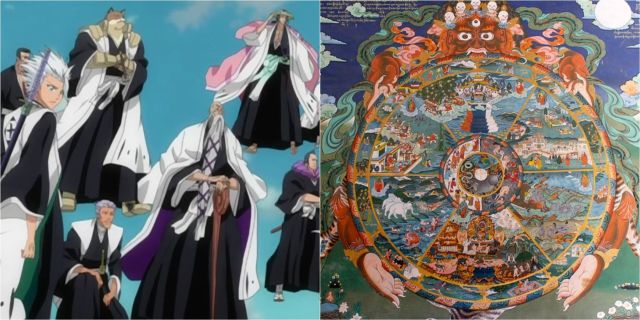Highlights
- Bleach incorporates Buddhist mythology, with the Soul Society representing the realms of existence and reincarnation, adding depth to the story.
- The concept of the Wheel of Life, with six planes of existence, is depicted in Bleach, with the Soul Society representing the Deva realm.
- The lower realms of existence in Bleach, such as Hueco Mundo and the concept of Hell, draw inspiration from Buddhist mythology, adding to the balance of the series.
Several anime series tend to draw inspiration from Buddhist mythology, enriching their worlds through notions that belong to this ancient religion. Bleach is no stranger to these concepts as author Tite Kubo has incorporated a multitude of references that can be traced back to the Buddhist religion. While some references are apparent, others are subtle and deeply interwoven in the show’s premise.
One such aspect that has roots in Buddhism is the Soul Society itself, representing the realms of existence and the concept of reincarnation. In fact, every single realm showcased within the series alludes to a plane of existence within the cycle of life. Moreover, the events taking place within the Soul Society tie in with the show’s use of Buddhist cosmology, adding a layer of depth to an already profound narrative.
RELATED: The Best Anime About Japanese Folklore
The Samsara of Life

The Wheel of Life is a core concept in Buddhist cosmology, depicting the circle of life and rebirth. With a total of six planes of existence, humans are reborn into these realms based on their sins and actions in their past lives. The Deva and Asura realms are planes of existence that host gods and demi-gods, and those that possess a certain level of enlightenment reach these realms.
The Soul Society is akin to the Deva realm as only those with good deeds in their past lives reach this plane of existence. However, elements of Asura are also vehemently present within the Soul Society as its inhabitants do not truly represent beings that have reached enlightenment. Since the Asura realm is known to contain demons as well, the Soul Society could possibly be a mix of Deva and Asura realms, with the Rukon District being the Asura counterpart.
The Human and Animal planes coexist in the human realm, and this plane of existence is known as the World of the Living within the series. The last two realms, Preta and Naraka, are also thoroughly represented in the series, with Preta accurately representing the land of Hollows and Hell being a separate plane already present in Bleach. The series’ reincarnation follows this very system as humans are reborn in the newer realms based on their sins and actions in the world of the living.
Soul Reapers as Gods of Their Realm

As the Soul Society has its roots in the Deva realm, it’s only natural for its inhabitants to be akin to the Devas themselves. Many parallels can be drawn between Soul Reapers and the gods that inhabit the Deva plane, indicating a clear reference to the Buddhist mythos. While many confuse the Deva realm as a plane of existence similar to heaven, it is merely a place where gods reside. The Soul Society works in a similar fashion as this world doesn’t take on the role of a traditional heaven, instead depicting a realm where blessed souls reside.
RELATED: Bleach: The Most Dangerous Soul Reapers
The similarities become even more apparent once the inhabitants of these realms are compared to one another. The gods that populate the Deva realm enjoy luxury that is only available to them, basking in ignorance while the lower realms suffer in perpetuity. The Soul Reapers residing within the Soul Society have a similar outlook on life as they completely disregard the plight of the Rukon District. Instead, they live in their own little bubble of peace and luxury within the Soul Society’s walls.
The Lower Realms of Existence

With the Soul Society taking on the role of the highest plane of existence, the other realms have also found their place within Bleach’s framework. The most prominent of these lower realms is Hueco Mundo, a plane that exists somewhere between the Soul Society and the world of the living. Hollows populate this endless world, roaming throughout the lands in search for lost souls that stumble into this world.
Hueco Mundo clearly alludes to the Preta realm within Buddhist mythology, as the Buddhists describe this world to be populated by ghoulish beings that bear an insatiable hunger. Hollows seem to fit this description quite accurately as these lost souls possess an insatiable hunger for human souls. Despite devouring hundreds of souls, these creatures remain unsatisfied as they hunt for more prey.
Lastly, the Naraka realm is represented by the concept of Hell or the Underworld. Hollows that committed atrocious crimes in their past lives are sent to the Underworld instead of the Soul Society when cleansed by a Soul Reaper. While this concept is rarely expanded upon in the series, the notion of Hell existing in Bleach has been cemented by the multiple appearances of the Gates of Hell. From the Soul Society to the concept of the Underworld, Bleach has proven that it takes inspiration from Buddhist mythology, balancing its realms through the Samsara of Life.
Bleach is available to stream on Crunchyroll.











Leave a Reply